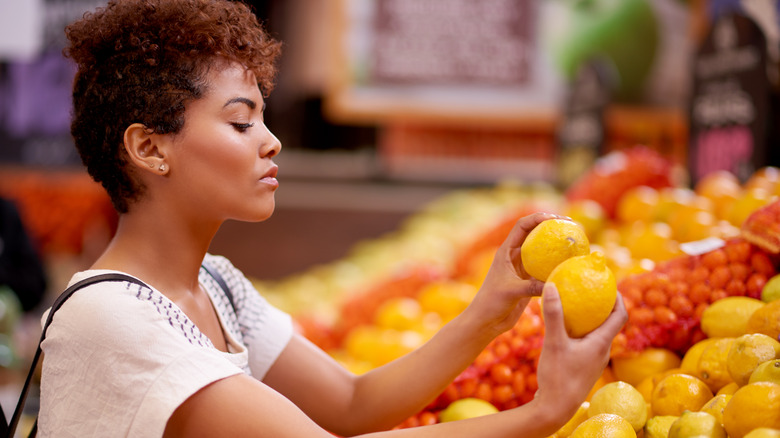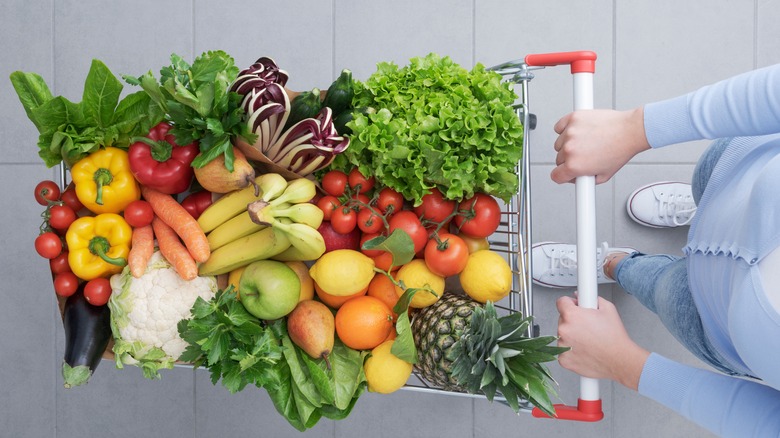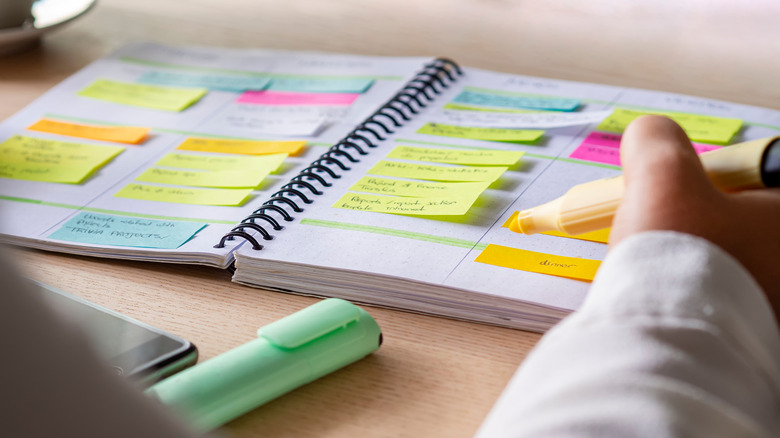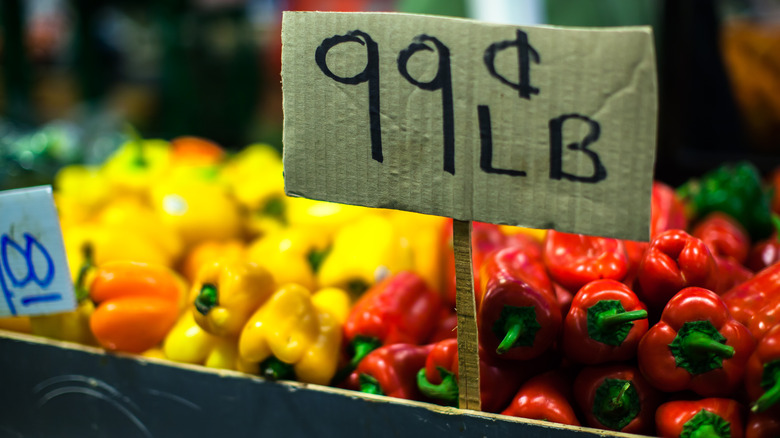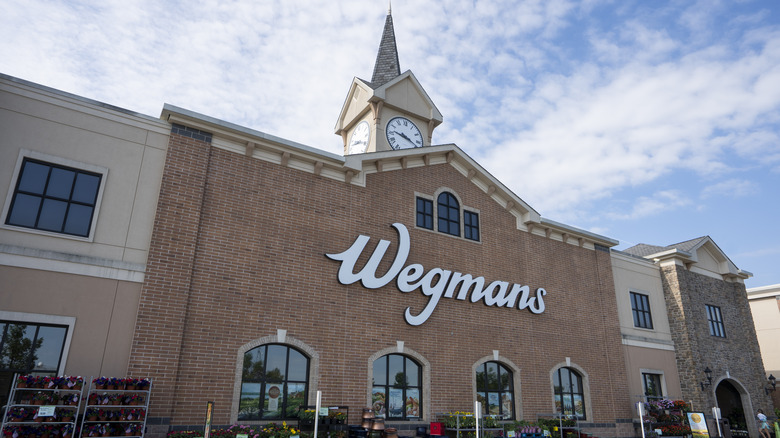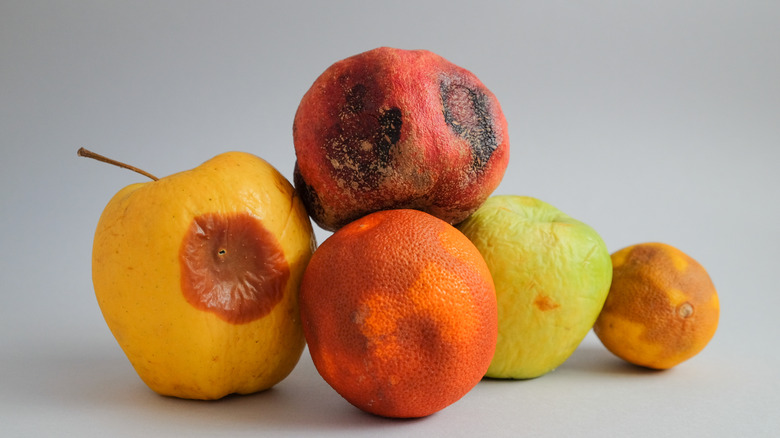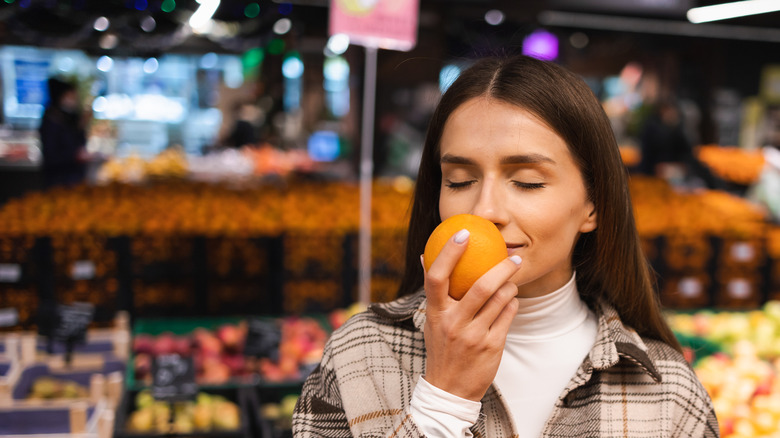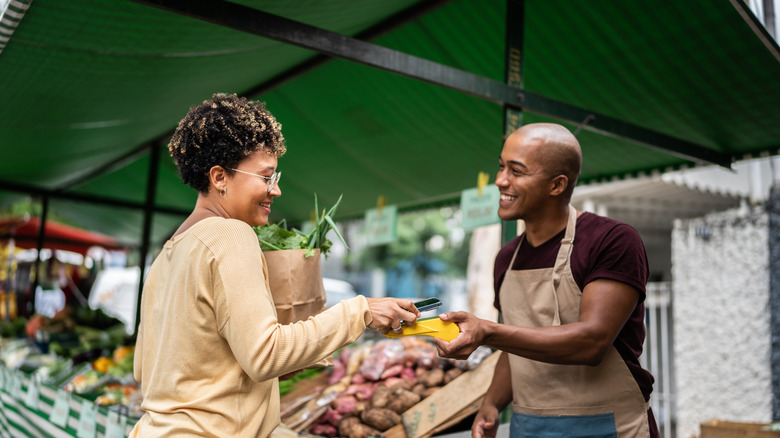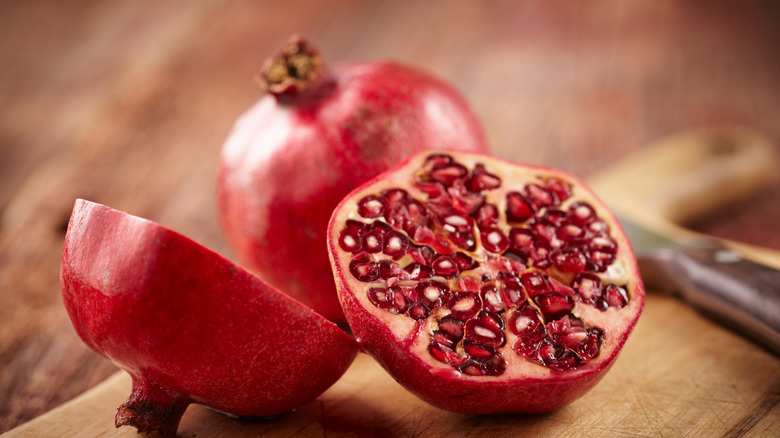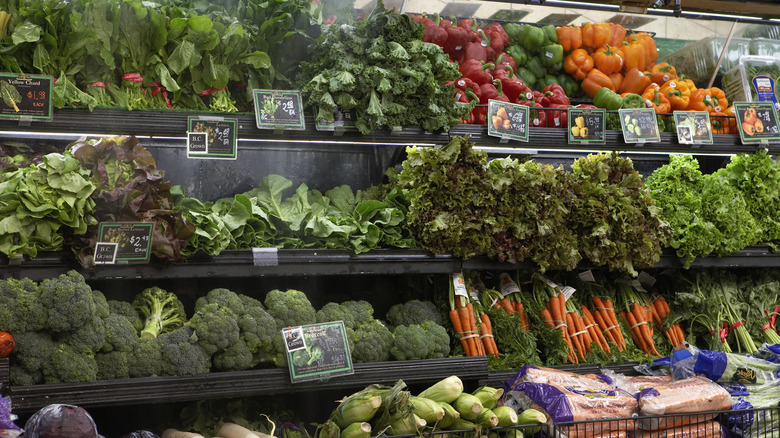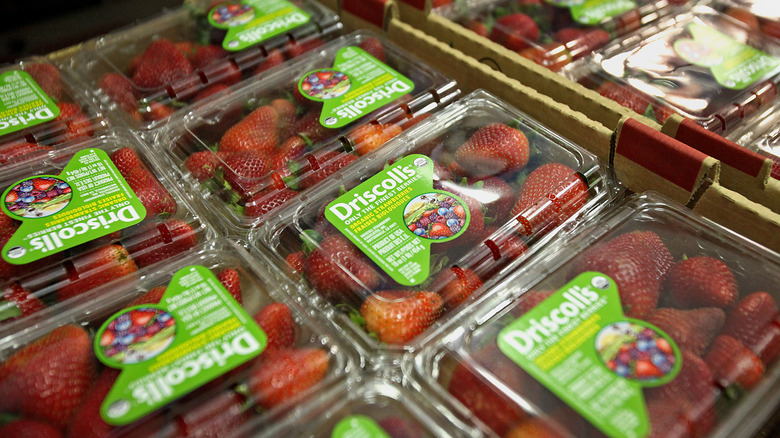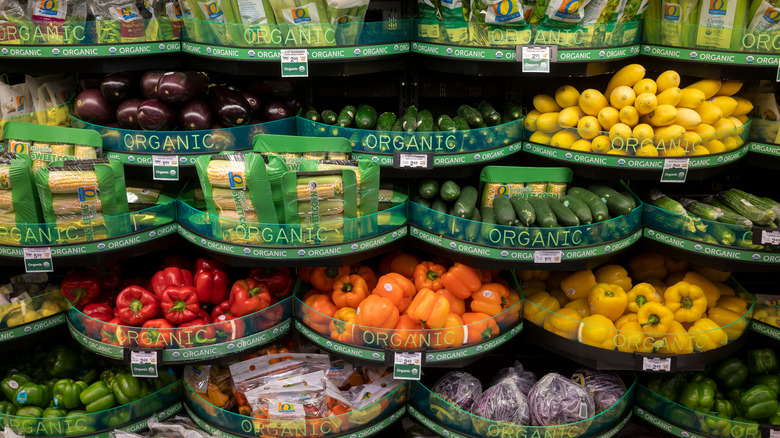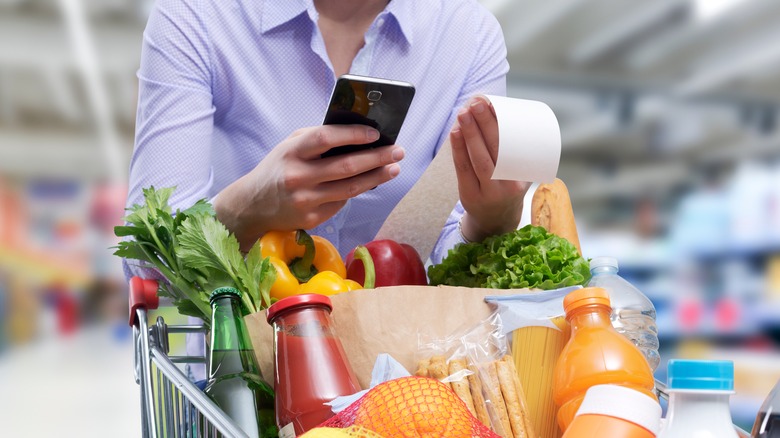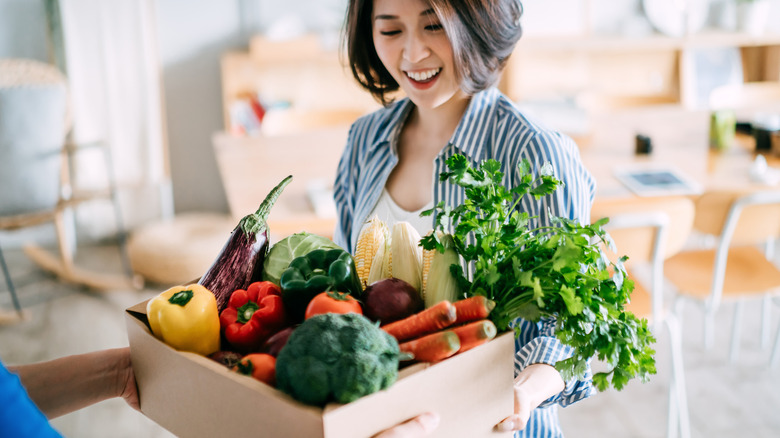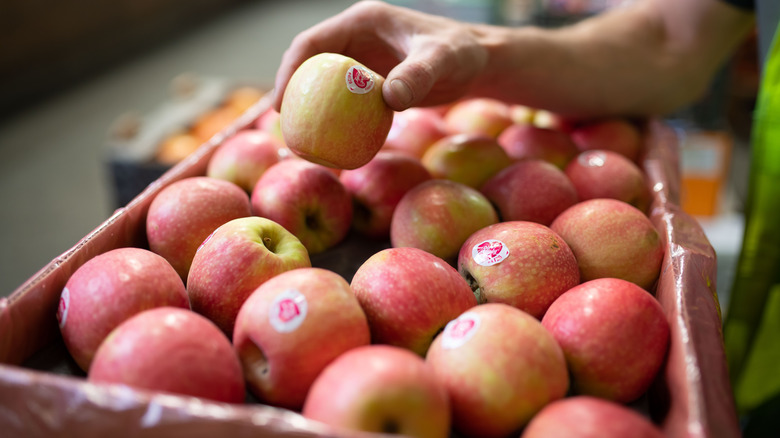14 Mistakes You Might Be Making When Buying Produce
Fruits and vegetables are a healthy part of any diet. However, buying produce isn't always easy. Grabbing an apple, a carton of strawberries, or a head of lettuce off of the shelf doesn't always guarantee that same reliable taste. These items aren't as consistent as processed foods like bags of chips. This is because there can be so much variability between produce. Even with one large bin of apples at the grocery store, some could be juicy and delicious, while others may taste soft and mealy.
There are common mistakes people make when shopping for produce. These errors can leave shoppers with bland, underripe, overripe, or otherwise unenjoyable produce. In addition to not understanding how to choose the freshest and best-tasting produce, you may also be going wrong with where you're getting your produce from, or how much you're paying for it. Read on to learn more. We'll help you understand how to select the most delicious fruits and vegetables for snacking or adding to your favorite recipes.
1. Buying more than you'll eat
One of the most common mistakes that people make when shopping for fruits and vegetables is buying more than they'll actually eat. It can be difficult when you're in the grocery store, surrounded by all of the colorful produce. Everything can look good, and you may have high hopes that you'll eat everything you buy.
However, too many times, your schedule changes. In other cases, you end up going out for a few meals instead of eating at home. Then, all of a sudden, you have way more fruits and vegetables than household members could possibly eat before they spoil. What ends up happening a few days later? A lot of produce ends up in the trash can — or, in slightly better cases, the compost bin.
Not only is this a waste of your hard-earned money, but it's also contributing to a much larger problem that we have in America: food waste. It is estimated that individuals in the United States let approximately one-third of all of the food they purchase go to waste. This leads to more trash filling up our landfills. It also wastes food that could have otherwise fed a family in need.
2. Not meal planning or making a grocery list
One of the top ways to reduce food waste is to do some meal planning before your grocery trip. Meal planning gives you the opportunity to look over recipes and determine which produce items you need. It also allows you to decide on the quantities of each produce item to purchase, helping to prevent wasted fruits or vegetables. Meal planning can even help ensure that you're eating a balanced diet throughout the week.
Another benefit of meal planning is that, when done on a weekly basis, it can save those annoying mid-week runs to grab one or two missing produce items. If you make your plan for the week before putting together your grocery list, you can add all of the items you need to your list to cut out the need for a second (or third) shopping trip later in the week.
According to the Centers for Disease Control and Prevention, meal planning can also offer various health benefits. Instead of going through the drive-thru for a last-minute dinner, you'll already have everything you need to make a more nutritious meal at your house. If you're worried about having enough time to cook, consider making some freezer meals ahead of time, or choosing some simple slow cooker recipes that you can use to minimize your cooking time in the evening.
3. Ignoring the sales
Part of your meal planning process for each week should involve looking through your grocery store's weekly advertisement. When doing so, you should be paying attention to the different produce items that are on sale. It goes without saying that buying items that are on sale will help you save money on groceries. While sales will vary — and some grocery store advertisements may not offer as substantial savings as others — every penny adds up.
For example, most stores carry several varieties of apples. Imagine that Red Delicious apples are on sale for $1.10 per pound, while Fuji apples, which are not on sale, are selling for $1.40 per pound. While 30 cents doesn't sound like much, if you buy 12 apples each weighing one-third of a pound, you'll end up saving over $1 on just that one item. Those 12 Red Delicious apples would cost approximately $4, while a dozen Fuji apples would cost around $5.
4. Going to the wrong store
Before you even step into a grocery store, you might be making a major produce-buying mistake. The error could be going to the wrong grocery store in the first place. It can be easy to assume that the produce offered by different grocery stores will be the same, but it just isn't the case. Beyond offering a varied selection of fruits and vegetables, each grocery store's produce quality can also vary.
You may have made your own notes about this during your shopping trips. Luckily, that's just part of a wider discussion of this topic. Consumer Reports conducted a survey comparing the quality of the fruits and vegetables at various grocery stores. It revealed five grocery chains that consistently offer a good selection of high-quality produce: Wegmans, Heinen's, Central Market, Gelson's, and New Seasons Market.
It is unlikely that Consumer Reports was able to visit each of your local grocery stores, so you may have to do some of your own research. Shop around some, and compare the quality of the fruits and vegetables across different grocery stores close to your home. Also, take note of the selection and the number of different options each store offers.
5. Buying overripe or spoiled fruit
When you pick ripe fruit at the grocery store, it will be ready to enjoy right away. However, what you want to avoid is picking fruit that is already overripe or spoiled. If you're not really paying attention, it can be easy to accidentally grab something that is already past its peak. To avoid doing so, it's important to know what you're looking for.
Start by picking up the fruit in question to check how it feels. If you press gently and it feels mushy, it is probably overripe. Similarly, if the skin is shriveled, wrinkly, or otherwise not looking right, it's best to put the fruit down and look for another option.
Berries can sometimes be more difficult to pick, because of how they are packaged. Gently rotate the package, taking a close look at the berries inside. Take note of the color. If strawberries or raspberries look overly dark, they're probably past their peak. If you see any signs of mold in the package, you'll definitely want to put it down in favor of another pack. Any strawberries that have mold on them will be inedible. Even if it's just a small amount of mold, the mold will have already penetrated into the flesh of the berry, meaning you could get sick if you eat it (via Eating Well). If you only see mold on one berry at the store, it can spread to other berries in the container quickly.
6. Not smelling fruit before you buy it
While it is important to trust your gut when making many decisions, you'll want to rely more on your nose when selecting fruit. If you pick up fruit and put it in your shopping cart without smelling it first, then you could be making a big mistake. Smelling fruit can provide a lot of information about if the fruit is ripe and will offer the best flavor.
Take a few extra minutes in the produce section to hold each piece of fruit you're thinking about buying up to your nose. You're looking for fruit that has a fragrant and lightly sweet aroma. It should be pleasant to smell, and should not be too strong. Otherwise, it is likely a sign that the fruit is overripe and has started fermenting. If you smell the fruit, but can't detect any real odor, it probably means that the fruit isn't ripe yet. A lack of smell could also mean that a particular piece of fruit is bland. Stick with pieces of fruit that give off a mild, pleasant aroma.
7. Skipping the farmers market
When you're on a quest to find the freshest produce, where you shop matters. We already mentioned that some of your local grocery stores may have a better selection of higher-quality fruits and vegetables than national chains. However, there's another option that's even more likely to yield a ripe, fresh, and delicious bounty for you to enjoy: the farmers market. When you shop at a farmers market, you'll find a selection of locally-grown produce. In addition to supporting the local economy and farmers in your area, there are other advantages to shopping at these places.
Because this food is grown locally, it will be fresher than the produce you get at the grocery store. This is because farmers market produce usually comes from nearby, meaning it spent less time in transit. If something is available at the farmers market, you can be confident that it is in season. This means it's more likely to offer the best flavor.
You'll also have the advantage of more personalized service. By talking to one of the people responsible for growing the fruits or vegetables you're looking at purchasing, you can find tips on how to pick the best items, ways you can eat them, or even different recipes you can make using them.
8. Not trying something new
It's easy to get into a rut and always buy the same fruits and vegetables. However, variety is the spice of life. If you only eat the same things every week, you're depriving yourself of the opportunity to discover something new and exciting. Moreover, by always eating the same produce items, you're making it more likely that you're going to get bored with them and resort to less healthy eating habits.
The next time you go to the grocery store or farmers market, spend a few extra minutes looking around. Try to find one or two new fruits or vegetables to try. For example, branch out and try a new variety of summer squash. Instead of eating familiar favorites like zucchini or yellow squash, see if you can find eight-ball zucchini, zephyr squash, or pattypan squash to try instead. Other unique fruits and vegetables that you might not have heard of include daikon radishes, dandelion greens, jicama, tomatillos, pomegranate, star fruit, pomelos, and Swiss chard.
9. Not buying enough vegetables
Do you leave the grocery store with a cart full of fruits, but only a few vegetables? If so, now is the time to change your shopping and eating habits. According to the U.S. Department of Agriculture, vegetables provide a range of essential nutrients for our bodies. These can include vitamin A, vitamin C, fiber, potassium, folate, and more. They help us to maintain healthy blood pressure, lower blood cholesterol, and keep the skin, eyes, teeth, and gums healthy. Moreover, vegetables are also low in calories and fat, making them a good way to fill yourself up without overindulging.
While the recommended serving of vegetables per day varies based on age and gender, most adults should be eating a minimum of two cups each day, if not more. To help you visualize this recommendation, one cup of vegetables equals about one large tomato. Other equivalent serving sizes include one large bell pepper, two medium carrots, one avocado, or two large celery stalks.
10. Buying off-season fruits or vegetables
Whenever possible, opt to purchase in-season fruits and vegetables over their out-of-season counterparts. Growing seasons can vary based on where you live. This means that, when you buy produce that is in-season, you will be able to find more fresh and local options. You won't have to rely on something that was shipped from miles away. Shipped produce has to be picked earlier, to make sure it doesn't spoil before purchase. For this reason, out-of-season items in your grocery store were likely picked before their peak freshness. This means they may not ripen up once you bring them home.
Not only is locally-grown and seasonal produce going to taste better, but it also may be more affordable. Prices are marked up to ship items across the country or overseas. However, seasonal items may be growing in abundance on local farms, allowing farmers to offer them for more discounted prices.
Additionally, buying local and in-season produce has a potentially good environmental impact. It means there's less of a demand for shipped items, which require vehicles to transport them. Over time, this decreased demand could lead to decreased greenhouse gas emissions, which are linked to climate change, from transportation.
11. Not shopping organic
Another mistake many people make when shopping for produce is overlooking the importance of selecting organic fruits and vegetables. Many people balk at the higher costs of organic foods, figuring that they're fine just sticking with conventional items. However, when you take a moment to learn about the benefits of choosing organic foods — and the possible consequences of consuming non-organic fruits and vegetables — you might just change your mind.
When growing conventional produce, various chemicals and pesticides are used. Residues of these chemicals remain on the fruits and vegetables. Moreover, fruits and vegetables can even absorb these harmful substances, so simply washing them off isn't going to remove all of the potentially dangerous chemicals.
With organic produce, on the other hand, no pesticides or chemicals are used during the growing process. Also, the methods used by organic farmers can help protect the environment more than those used by conventional farmers. Pesticides and other chemicals won't be mixed with runoff water, potentially threatening nearby animals. Organic farming can also decrease soil erosion and make the soil more fertile for healthier crops.
12. Not using a cash-back app to save money
Have you downloaded phone applications like Ibotta, Fetch, or Receipt Hog? These grocery store programs are designed to help users save money. If you have seen apps like these, you may assume that they won't do you any good in the produce section, or that they'll only be able to help you save money on packaged items. However, that isn't the case.
Some apps offer points or rewards for scanning any receipt — regardless of what you bought or how much you spent. While it may not be a huge payout, if you consistently save and scan your receipts, the rewards will start to add up. Plus, turning in your receipts only takes a few moments. You won't need to commit much of your time to start accumulating rewards, which you can later cash in for a deposit in your account or a gift card, depending on the specific app you use. In the end, you could put this money towards buying some fruits or vegetables from the store's produce section.
13. Not trying a produce delivery box from a local company
Hand-picking your own produce can be rewarding. However, it can also be time-consuming. We've also already established that you're not always able to find the ripest and freshest fruits and vegetables in the produce section of your local grocery store. In addition to farmers markets, there are other options. One way to bring some fresher pieces of produce into your home is to sign up for a produce delivery box, or community-supported agriculture (CSA) subscription, from a local farm or co-op.
If you're not familiar with what a produce delivery box is, it is precisely what it sounds like. It's a box of produce that will be delivered straight to your door. Depending on the company you choose to work with, you can customize the frequency of delivery and the size of the box you choose. Search around your area for a local company offering such a service to help ensure that you get the freshest produce possible. Many will companies or local farms will offer pre-built boxes, organized with a set selection of fruits and vegetables for the week. However, others may let you customize your selections, adding individual items of your choosing.
14. Not stocking up on sale or in-season items for later use
Did you know that you can freeze fresh fruits and vegetables? This can help you take advantage of excellent sales at the store, or allow you to purchase more in-season fruits or vegetables.
If you're going to freeze fruit, it is important to make sure that it is ripe. It will not continue to ripen once you freeze it — or even after it is defrosted. Give it a few days, if needed, to get nice and ripe. The best way to freeze fruit varies based on the type. Berries, grapes, and other small items can be laid out on a metal baking dish, then frozen in a single layer, before being transferred to a freezer-safe bag. When freezing apples, remove the core, slice them, and steam them for about two minutes before freezing them. If you want to freeze bananas for your smoothies, they can be sliced, laid flat on a metal baking dish, then transferred to a freezer bag.
Many vegetables — including cauliflower, broccoli, corn, green beans, zucchini, and peas — will need to be blanched before serving. To blanch these vegetables, you want to add them to a pot of boiling water for a few minutes, drain them, and then let them cool completely. Finally, you can lay them out in a single layer on a metal baking dish to freeze, before moving them to a freezer bag.
